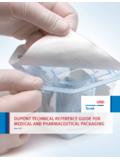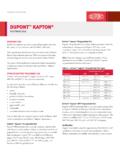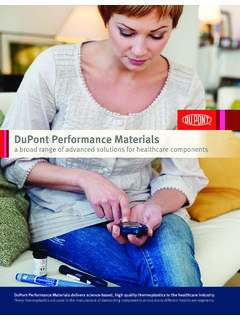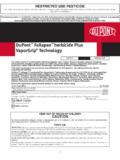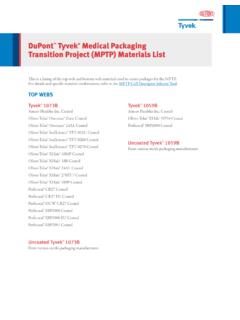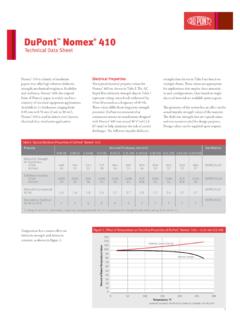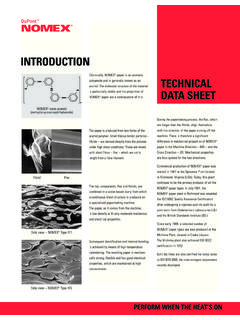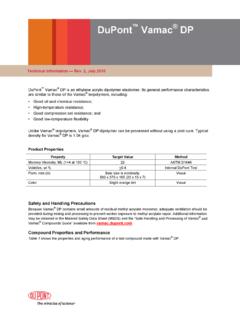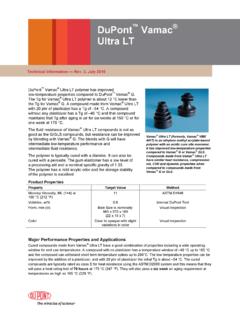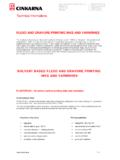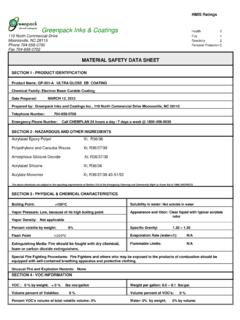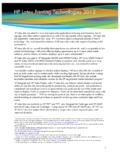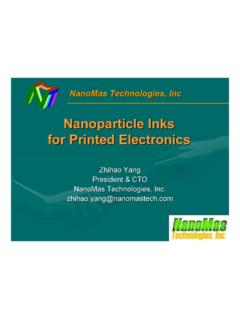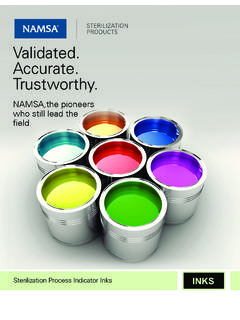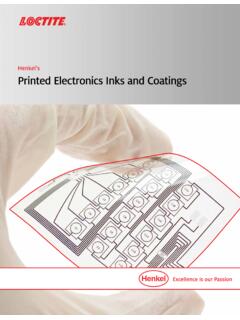Transcription of Processing Guide for DuPont Luxprint® …
1 Processing Guide for DuPont luxprint . electroluminescent inks (Revised May 2012). Introduction Recent major advances in materials and electronics technology, as well as new demands on lighting technology from the marketplace have provided the opportunity for a fundamental shift in the role of electroluminescent (EL) technology. For that reason, DuPont has developed a system of conducting, insulating and luminescent inks suitable for manufacturing printed lamps, enabling companies skilled in screen-printing of electronic circuitry to easily manufacture flexible EL lamps. The main EL characteristics are: Uniform surface illumination of complex shapes Thin, flexible and light weight Low power consumption Very low heat generation Vibration and impact resistant The EL lamp is essentially a capacitor structure with an inorganic phosphor (zinc sulphide compound) sandwiched between the electrodes. Application of an AC voltage across the electrodes generates a changing electric field within the phosphor particles causing them to emit light.
2 For most EL lamps, an inverter is used as a power source. An inverter is a DC-AC converter, which typically generates 60-115V AC and frequencies in the region of 50-1000 Hz. For signage applications much higher frequencies can be used to increase lamp brightness. Light output gradually decays with time, as the luminescent efficiency decreases. The presence of moisture accelerates this decline. The phosphors used in DuPont luxprint EL inks are micro- encapsulated to hinder the penetration of moisture and thus to prolong the useful life of the lamps. The polymer binders in the DuPont luxprint EL pastes have been selected to provide a barrier, which further protects against moisture-related aging phenomena. Higher voltages and frequencies, as well as elevated temperatures during operation, will reduce the lifetime of the lamps. Operation at lower temperatures, voltages and frequencies should be encouraged, with 80 - 120 V AC and 400 Hz being typical conditions.
3 The following provides descriptions of process steps and materials which have proven important in successful implementations of the DuPont luxprint EL system to date. The recommendations and descriptions found herein are based upon experience gained during the development of these inks . Process optimization will be necessary to conform to the particular design of the EL lamp and Processing equipment used. These guidelines may not prove applicable for new or different applications, and the user must carefully evaluate their usefulness in each case. The DuPont luxprint materials system provides the inks needed to make EL lamps by screen printing. Other materials, such as the transparent sputtered ITO (Indium Tin Oxide) polyester substrate, as well as the power supply, must be obtained from other sources. Each of these inks is designed to be used without further dilution in a screen-printing process. The products are mutually compatible, and provide excellent adhesion to ITO, which is typically utilized as a thin conductive coating on polyester, or other film base.
4 EL Application - Advertising (POS) An eye-catching series of Sequenced lighting patterns 81XX Type System: Higher brightness/moisture resistance than the 71 XXJ System and designed for more demanding applications. Table 2 Product Number Phosphors 8150B or 8150L White Phosphor 8152B or 8152L Blue-Green Phosphor 8154L Yellow-Green Phosphor Dielectrics 8153 High K Dielectric Insulator Conductors 8144 Rear Electrode, Carbon Conductor (with UV Encapsulants). Build Sequence 1 7152 Rear Electrode, Carbon Conductor (with 7165 Encapsulant). 7162 Front Electrode, ATO (Antimony Tin Oxide) Translucent Conductor 9145 Rear Electrode, Silver Conductor (also for bus-bar and termination). Conductors 7102 Rear Electrode, Carbon Conductor (if overprinting 5000 Ag). Build Sequence 2 7105 Rear Electrode, Carbon Conductor 5000 Rear Electrode, Silver Conductor (also for bus-bar and termination). 7164 Front Electrode, ATO (Antimony Tin Oxide) Translucent Conductor Protective 5018A Clear UV Cure Ink Encapsulant 5018G Green UV Cure Ink Build Sequence 1 5018 Blue UV Cure Ink 7165 Clear Solvent Ink (single print only).
5 EL Application Advertising (POS) Glowing Eyes Sequence DESIGN NOTES. The printed EL lamp consists of a sandwich structure containing an appropriate substrate, a rear electrode, an insulating layer, the phosphor layer, a transparent or translucent front electrode and a protective layer (see schematic diagram). The lamp may be terminated by a silver conductor, and crimped connectors (or other means) to allow connection to the power source. Care must be taken in providing a connection with good integrity. For outdoor use additional moisture protection and UV protection are essential. There are various lamp builds possible, with the two most common constructions described below. Build Sequence 1. Uses a transparent base substrate. Polyester film, sputtered with ITO or coated with a conducting polymer, can be used as the front electrode. Alternatively, a screen printed conducting translucent ink can be used on a clear base substrate. The build sequence printed on top is simply phosphor, then either: (a) 2 prints of dielectric (< 25 microns total dried thickness), which will give a brighter lamp but may reduce the yield and reliability, or (b) 3 prints of dielectric (> 25 microns total dried thickness) (preferred) for optimum yield and reliability, Followed by the rear electrode.
6 Build Sequence 1. Protective encapsulant Rear electrode Dielectric AC. Phosphor ITO film or translucent conductive ink on polyester Light A printed silver bus-bar along the perimeter of the lamp should be used for large areas in order to provide more even illumination of the lamp. For the rear electrode, a silver or carbon conductor is generally used. For larger lamp areas, carbon is not suitable alone, unless it is overprinted with a silver grid, as the carbon resistance is too high. The final product should be laminated to provide protection from moisture and electrical isolation, for safety reasons. Alternatively, a protective layer can be screen-printed using UV cure ink or solvent ink. (See Diagram Build Sequence 1). 5018/A/G screen printable UV cure inks or 7165 solvent ink can be used as an encapsulant in order to provide electrical insulation and extra protection against humid environments. The UV. encapsulants do not adhere well to ITO-sputtered film, so it is recommended to limit the print area of the 5018/A/G to that of the underlying dielectric.
7 7165 adheres well to ITO film but can only be used in a single print. In more complex EL lamp constructions, 2 layers of 5018/A/G can be used as an effective insulator where conductor crossovers are present. Printing local crossovers may cause cracking over the dielectric, and it is therefore advisable to print the first UV encapsulant layer over the whole lamp area. A thick, single print of 7165 solvent encapsulant can be used as an option. When using a carbon rear conductor, 7165 should be used over 7152 instead of 8144. Build Sequence 2. Various substrate types could potentially be used. Using a translucent conductive ink, it is possible to use other base substrates as long as these are compatible with the solvent and resin system and are capable of withstanding the elevated temperature drying conditions. Build Sequence 2. Light Clear Encapsulant Translucent Conductor Phosphor AC. Dielectric Rear electrode on a compatible substrate The build sequence here is reversed with the rear electrode printed first.
8 Again, as in Build Sequence 1, a silver bus-bar is recommended. A silver underprint should be applied if a carbon electrode is used for larger areas and/or humid environments. Two dielectric layers are then printed followed by the phosphor and finally the conductive translucent front electrode. (See Diagram Build Sequence 2). Lamps must be protected against moisture and fully evaluated prior to use. SUBSTRATE TYPES. -Sputtered ITO Polyester The substrate is typically obtained with an ITO transparent conductor sputter-coated on one side. Polyester thickness between 100 - 175 m and resistivities ranging from 50 to 30 /sq can be used although 200 /sq or less is recommended. Heat stabilized film is highly recommended as drying temperatures up to 130 C may be required. It is also recommended that suitable tests be carried out to verify the compatibility of the substrate with the inks . -Non ITO Coated Films These are polyester or other film types coated with a conducting, transparent polymer.
9 Resistivity is high, typically 100 /sq to 300 /sq. Lamp performance must be thoroughly tested for compatibility, including initial and aged performance. -Alternative use of Mylar polyester and conductive translucent inks In designs with small-lit areas, screen printable translucent conductive ink can be used as the front electrode. This provides a total screen printed solution to lamp fabrication and a lower cost alternative to lamps manufactured on ITO film or coated polyester. Using this option, some consideration should be given to the following: Resistivity The as-printed resistivity of translucent conductors can be around 100 times that of ITO. film. Consequently, lit areas need to be kept small so that good uniformity of illumination is achieved. Test lamps have been constructed with an area 10cm x 5cm without noticeable darkening towards the center of the lamps (powered at 100V/400Hz). Although there are no data available as to the maximum lamp area that can be lit, this can be established by investigating various lamp designs, Processing parameters and drive conditions.
10 Frequency Higher frequency operations may cause darkening towards the center of the lamps. It is advisable to use frequencies below 800Hz. Bus-Bar It is highly recommended to print a silver bus bar close to the lit area around the perimeter of the translucent conductor. This improves the light uniformity by lowering the contact resistance and minimizing voltage drop across the surface (vs. using a carbon electrode). Paste Selection Depending on the build sequence to be used, paste selection is critical to the performance of the lamp. a) Build Sequence 1. - It is advisable to use a heat stabilized, print treated polyester. - Translucent conductor 7162 is printed first. This uses ATO conductive particles, which have a neutral gray color. - 9145 silver bus bar printed next (optional if carbon rear electrode). - Phosphor is printed next, with a choice of output color. - The phosphor is followed by 2-3 layers of dielectric. - 9145 Silver or 8144 Carbon is printed onto the dielectric.
